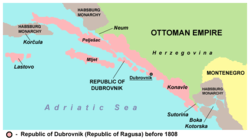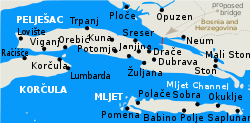Pelješac
Pelješac (Croatian pronunciation: [pɛ̌ʎɛʃats]) (local Chakavian dialect: Pelišac; Italian: Sabbioncello) is a peninsula in southern Dalmatia[1] in Croatia. The peninsula is part of the Dubrovnik-Neretva County and is the second largest peninsula in Croatia. From the isthmus that begins at Ston, to the top of Cape Lovišta, it is 65 km or 40 mi long.
Etymology
The name Pelješac is most likely derived from the name of a hill above town of Orebić, which is Pelisac. This is a relatively new name for the peninsula. Throughout history other names have been used such as Stonski Rat, Puncta Stagni, Ponta di Stagno and Sabbioncello.
Geography
The Bay of Mali Ston separates the peninsula from the Klek peninsula of Bosnia and Herzegovina and from the Croatian "mainland". The Strait of Pelješac is located at its far western end, and it divides the peninsula from the island of Korčula. On the west part of Peninsula is the highest summit of Pelješac, 961 m or 3,153 ft.
Municipalities
Administratively the peninsula is divided into the municipalities of:
History
Prehistory
The earliest known historic records of Pelješac are from ancient Greece. The area became part of the Roman province of Dalmatia after the Illyrian Wars (220 BC to 219 BC.).[3] Roman migration soon followed. In the 6th century Pelješac came under Byzantine rule. Upon the arrival of the Croats, the area of the Neretva (from the northern Herzegovina mountains to Rijeka Dubrovačka) was established by the prince of Zahumlje - same as Neretva, Primorje and Herzegovina, which also belonged to Ston with Rat (Peljesac) and Mljet. Local rulers acknowledged the supremacy of Byzantium. After Mihajlo Višević, who acknowledged the authority of Bulgarian Simeon, Zahumlje was ruled over by different dynasties. Around 950, it was briefly ruled by Duke Časlav. At the end of the 10th century, Samuilo was the Lord of Zahumlje, and the dukedom belonged to king Ivan Vladimir. In 1168, the Dukedom and Zahumlje were conquered by Raški major prefect Stevan Nemanja. Thirty years later, Zahumlje was invaded by Andrija, the Duke of Croatia and Dalmatia. In 1254, Béla IV of Hungary conquered Bosnia and Zahumlje. From 1304, Zahumlje was ruled by Mladen Šubić, then again for a short period by Serb parishioners, and from 1325 by Stjepan Kotromanić, and finally by Dubrovnik.
The old Ston was located on the slopes of the hills of Gorica and St. Michael, south of the Ston field. There were several early Christian churches there, the largest of which was St. Stephen's Church. The bishopric church of Mary Magdalene stood until it was bombed by the Allies in 1944. The only church that still remains is the church of St. Michael, built in the middle of the late antique castrum.
The original old town was demolished in the earthquake of 1252. With the arrival of the Republic, a new city was built on today's location. When renovations were made at the church of St. Michael at the top of the hill, fragments of Roman decorative plaster, Roman tombstones and antique ceramics were found, confirming this assumption. According to some sources, Ston experienced a destructive civil war in 1250, and in these conflicts the city suffered a great deal of destruction.
The turbulent times at the beginning of the 14th century spread across the entire country of Zahumlje. The usurpation by the Branivojević brothers, forced the people of Dubrovnik to fight them in 1326 with the help of Stjepan Kotromanović (Stephen II, Ban of Bosnia). That year, Dubrovnik occupied Ston. The Dubrovnik people immediately began to build and establish a new Ston, to defend the Pelješac and protect the slaves from which they had earned big revenue. Since the conflict between the Ban in Bosnia and Serbian king, the Dubrovniks purchased Pelješac with Ston from both rulers in 1333.
Modern history

At the end of the 12th century Orthodoxy appeared in the Peljesac area, at the same time Catholic bishop is expelled from Ston. Since the end of the 14th century Orthodox priests are no longer on Pelješac.[4] When the Pelješac peninsula came under rule of Dubrovnik, since 1333 Catholic population predominantly live in this area,[5] with Orthodox Christians and Bogomils present.[6]
The Walls of Ston are large fortifications built by the Republic of Ragusa. They are the second longest walls in Europe. Ston also has one of the oldest salt planes in this part of the world.
The French Empire occupied the region in 1806, abolishing the old Republic, and in 1808 turned it into the Illyrian Provinces. In 1815 it was given to the Austrian Empire and since 1867 became part of the Cisleithania of the Dual Monarchy of Austria-Hungary. Between 1918 and 1991 it was a part of Socialistic Republic of Croatia within Socialistic Federal Republic of Yugoslavia.
Transport
Pelješac Bridge

An additional connection between Pelješac and the mainland is planned to be created through the proposal of the Pelješac Bridge. Once completed, this bridge would physically connect all of Croatia, which is now interrupted by the strip of land belonging to Bosnia and Herzegovina at Neum municipality. The land mass that cuts Dalmatia, Croatia in two, in order granting Bosnia and Herzegovina sea access. The start of construction has been continuously delayed until shipping rights and boundaries can be properly defined between the two countries.
See also
- Geography of Croatia
- Dalmatia
- Dubrovnik-Neretva county
- Republic of Ragusa
References
- John Everett-Heath. "Dalmatia." Concise Dictionary of World Place-Names. Oxford University Press. 2005. Encyclopedia.com
- "Stanovništvo prema narodnosti, po gradovima/općinama, Dubrovačko-neretvanska županija". Croatian Census 2001/Popis stanovništva 2001. (in Croatian). Croatian Bureau of Statistics.
- Wilkes, J. J. The Illyrians, 1992, p. 120, ISBN 0-631-19807-5,Page 160
- Zdenka Janeković Römer, 2005, Citizens, Inhabitants, Subjects, Foreigners, Heterodox in Medieval Dubrovnik,https://www.academia.edu/7621134/Gra%C4%91ani_stanovnici_podanici_stranci_inovjerci_u_srednjovjekovnom_Dubrovniku_Citizens_Inhabitants_Subjects_Foreigners_Heterodox_in_Medieval_Dubrovnik_ #page=13-16
- Irena Ipšić, 2013, Vlasništvo nad nekretninama crkvenih i samostanskih ustanova na orebićkome području u 19. stoljeću,https://hrcak.srce.hr/index.php?show=clanak&id_clanak_jezik=155415 #page=235
- Irena Ipšić, 2013, Vlasništvo nad nekretninama crkvenih i samostanskih ustanova na orebićkome području u 19. stoljeću,https://hrcak.srce.hr/index.php?show=clanak&id_clanak_jezik=155415 #page=235
Further reading
- Mišić, Siniša (1997). Ston i Pelješac od 1326. do 1333. godine. Историјски часопис. 42-43. Istorijski institut. pp. 25–32. GGKEY:8N4K5PNPTJC.CS1 maint: ref=harv (link)
External links
| Wikimedia Commons has media related to Pelješac. |